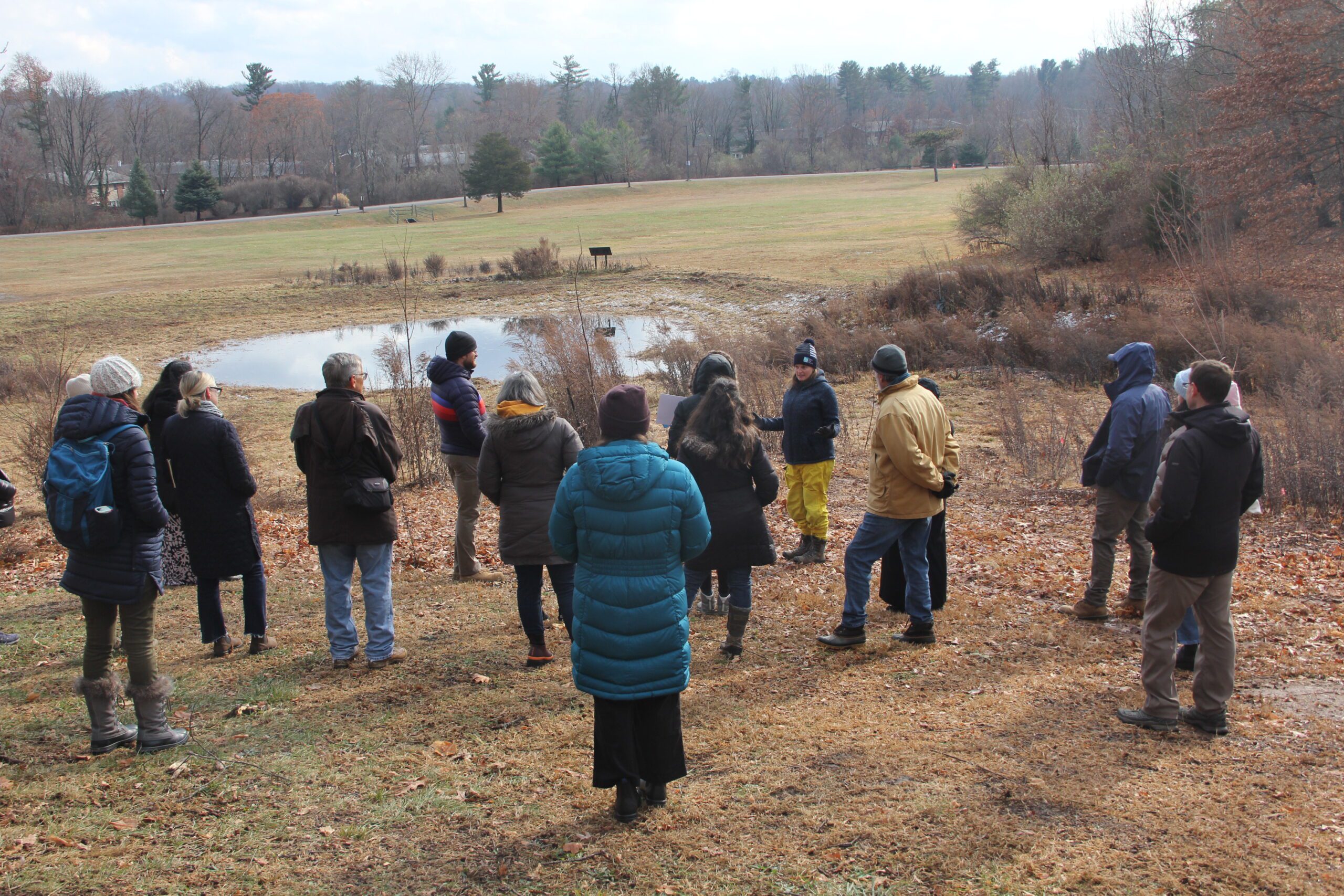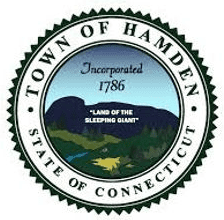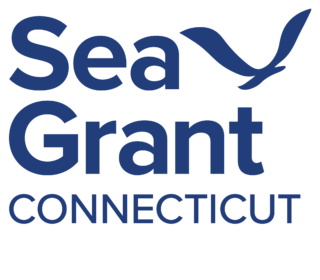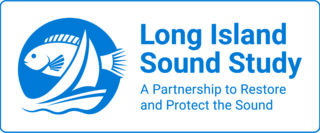Resource
Level of Effort:
Use this fact sheet to learn about riparian buffers and how they can be a tool for filtering excess nutrients and sediment from runoff, reducing flood impacts, and providing habitat. Learn more about buffers using this fact sheet. Details include what buffers are, why they are important, best practice recommendations, and design considerations.
Resource
Level of Effort:
Use this fact sheet to learn about riparian buffers and how they can be a tool for filtering excess nutrients and sediment from runoff, reducing flood impacts, and providing habitat. Learn more about buffers using this fact sheet. Details include what buffers are, why they are important, best practice recommendations, and design considerations.
Training
This field trip was part of a Community Resilience Project Showcase leading up to the 2024 Annual SRC Workshop.
 On December 5, 2024, the Sustainable and Resilient Communities (SRC) team of the Long Island Sound Study hosted a field trip featuring the Town of Hamden’s Bioretention Project – the largest municipally owned rain garden in the state! Participants began with a guided tour of the rain garden and bioretention areas at Town Center Park, where they heard from project planners and managers about its history, partnerships, challenges, and maintenance. Following this, participants gathered at the Hamden Government Center for a working lunch and presentations on topics including UConn’s Stormwater Corps, native plants, project engineering, and using nature-based solutions to advance climate resilience goals. The day concluded with a lively group discussion. Special thanks to our partners with the Town of Hamden, Save the Sound, the Hamden Land Trust, and UConn Extension.
On December 5, 2024, the Sustainable and Resilient Communities (SRC) team of the Long Island Sound Study hosted a field trip featuring the Town of Hamden’s Bioretention Project – the largest municipally owned rain garden in the state! Participants began with a guided tour of the rain garden and bioretention areas at Town Center Park, where they heard from project planners and managers about its history, partnerships, challenges, and maintenance. Following this, participants gathered at the Hamden Government Center for a working lunch and presentations on topics including UConn’s Stormwater Corps, native plants, project engineering, and using nature-based solutions to advance climate resilience goals. The day concluded with a lively group discussion. Special thanks to our partners with the Town of Hamden, Save the Sound, the Hamden Land Trust, and UConn Extension.
Photo credit: Judy Benson






Training
This field trip was part of a Community Resilience Project Showcase leading up to the 2024 Annual SRC Workshop.
 On December 5, 2024, the Sustainable and Resilient Communities (SRC) team of the Long Island Sound Study hosted a field trip featuring the Town of Hamden’s Bioretention Project – the largest municipally owned rain garden in the state! Participants began with a guided tour of the rain garden and bioretention areas at Town Center Park, where they heard from project planners and managers about its history, partnerships, challenges, and maintenance. Following this, participants gathered at the Hamden Government Center for a working lunch and presentations on topics including UConn’s Stormwater Corps, native plants, project engineering, and using nature-based solutions to advance climate resilience goals. The day concluded with a lively group discussion. Special thanks to our partners with the Town of Hamden, Save the Sound, the Hamden Land Trust, and UConn Extension.
On December 5, 2024, the Sustainable and Resilient Communities (SRC) team of the Long Island Sound Study hosted a field trip featuring the Town of Hamden’s Bioretention Project – the largest municipally owned rain garden in the state! Participants began with a guided tour of the rain garden and bioretention areas at Town Center Park, where they heard from project planners and managers about its history, partnerships, challenges, and maintenance. Following this, participants gathered at the Hamden Government Center for a working lunch and presentations on topics including UConn’s Stormwater Corps, native plants, project engineering, and using nature-based solutions to advance climate resilience goals. The day concluded with a lively group discussion. Special thanks to our partners with the Town of Hamden, Save the Sound, the Hamden Land Trust, and UConn Extension.
Photo credit: Judy Benson






Funding
: Jul 12, 2025
$500 - $1,000
Awards small grants in support of grassroots efforts and community-based environmental work in New England. The Grassroots Fund utilizes participatory grantmaking to move resources to New England grassroots groups working at the intersections of Environmental Justice. The program is geared toward groups who have some experience implementing a project in their community. Grants support groups to deepen their work by further developing a community vision, lowering barriers to participation, identifying new stakeholders, and working to bring more voices and lived experiences into core decision-making processes.
Funding
: Jul 12, 2025
$500 - $1,000
Awards small grants in support of grassroots efforts and community-based environmental work in New England. The Grassroots Fund utilizes participatory grantmaking to move resources to New England grassroots groups working at the intersections of Environmental Justice. The program is geared toward groups who have some experience implementing a project in their community. Grants support groups to deepen their work by further developing a community vision, lowering barriers to participation, identifying new stakeholders, and working to bring more voices and lived experiences into core decision-making processes.
Website
Level of Effort:
The Connecticut Invasive Plant Working Group website has information on events, invasive plant information for Connecticut, and control information. The mission of the Connecticut Invasive Plant Working Group is to gather and convey information on the presence, distribution, ecological impacts, and management of invasive species; to promote uses of native or non-invasive ornamental alternatives throughout Connecticut; and to work cooperatively with researchers, conservation organizations, government agencies, green industries, and the general public to identify and manage invasive species pro-actively and effectively. Organized in 1997 as an ad-hoc group, the Connecticut Invasive Plant Working Group (CIPWG) meets 1 to 2 times per year to collaborate and share information about invasive plant issues affecting Connecticut and the region. The group includes federal, state, and town agency staff, researchers, nursery growers, educators, master gardeners, community members, and interested citizens.
Website
Level of Effort:
The Connecticut Invasive Plant Working Group website has information on events, invasive plant information for Connecticut, and control information. The mission of the Connecticut Invasive Plant Working Group is to gather and convey information on the presence, distribution, ecological impacts, and management of invasive species; to promote uses of native or non-invasive ornamental alternatives throughout Connecticut; and to work cooperatively with researchers, conservation organizations, government agencies, green industries, and the general public to identify and manage invasive species pro-actively and effectively. Organized in 1997 as an ad-hoc group, the Connecticut Invasive Plant Working Group (CIPWG) meets 1 to 2 times per year to collaborate and share information about invasive plant issues affecting Connecticut and the region. The group includes federal, state, and town agency staff, researchers, nursery growers, educators, master gardeners, community members, and interested citizens.
Funding
: Jul 12 – Sep 30, 2023
$1,000
TREE CITY USA Reward Grants
The intent of this grant is to encourage municipalities to sustain their community forestry program and maintain their status as a Tree City USA through a celebratory tree planting in which large specimen trees or a grove of trees are planted in a prominent location within the community. The grants are made possible by a combination of U.S. Forest Service grant funds and unrestricted NYSUFC funds; applicants are sought in spring and/or fall and must have been a Tree City USA for at least the past five years.
Quick Start Grants
Through U.S. Forest Service funding, the NYSUFC offers Quick Start competitive grants of up to $1,000 each to small communities who want to pursue Tree City USA status, starting with an inaugural Arbor Day tree planting celebration in spring or fall.
Funding
: Jul 12 – Sep 30, 2023
$1,000
TREE CITY USA Reward Grants
The intent of this grant is to encourage municipalities to sustain their community forestry program and maintain their status as a Tree City USA through a celebratory tree planting in which large specimen trees or a grove of trees are planted in a prominent location within the community. The grants are made possible by a combination of U.S. Forest Service grant funds and unrestricted NYSUFC funds; applicants are sought in spring and/or fall and must have been a Tree City USA for at least the past five years.
Quick Start Grants
Through U.S. Forest Service funding, the NYSUFC offers Quick Start competitive grants of up to $1,000 each to small communities who want to pursue Tree City USA status, starting with an inaugural Arbor Day tree planting celebration in spring or fall.
Funding
: Jan 31 – Apr 4, 2025
$2,000-$15,000
Part C funding provides direct financial and staff support to conservation projects throughout Nassau County. Projects must meet one or more of the follow criteria in Nassau County:
Funding
: Jan 31 – Apr 4, 2025
$2,000-$15,000
Part C funding provides direct financial and staff support to conservation projects throughout Nassau County. Projects must meet one or more of the follow criteria in Nassau County:
Funding
: Jul 12 – May 20, 2025
$500
This program provides financial rewards for homeowners on Long Island who add green alternatives to their properties that reduce stormwater and nitrogen pollution entering Long Island Sound. Homeowners can be reimbursed for installing rain barrels, rain gardens, or native plantings on their properties. Application opened April 22nd, 2025 for this current season. Funds are limited and available on a first come, first serve basis.
Due to the high participation in the program, as of May 20, 2025 the Long Island Garden Rewards Program is closed. Thank you to all who participated. Check back for when applications open again!
Funding
: Jul 12 – May 20, 2025
$500
This program provides financial rewards for homeowners on Long Island who add green alternatives to their properties that reduce stormwater and nitrogen pollution entering Long Island Sound. Homeowners can be reimbursed for installing rain barrels, rain gardens, or native plantings on their properties. Application opened April 22nd, 2025 for this current season. Funds are limited and available on a first come, first serve basis.
Due to the high participation in the program, as of May 20, 2025 the Long Island Garden Rewards Program is closed. Thank you to all who participated. Check back for when applications open again!
Non-monetary Award
NYSDEC’s Trees for Tribs is a statewide program that works to reforest NY’s tributaries and create or improve riparian buffers that decrease erosion, reduce flooding damage, improve wildlife and stream habitat, and protect water quality.
Non-monetary Award
NYSDEC’s Trees for Tribs is a statewide program that works to reforest NY’s tributaries and create or improve riparian buffers that decrease erosion, reduce flooding damage, improve wildlife and stream habitat, and protect water quality.
Funding
: Jan 1 – Apr 15, 2023
~$1,500
The EPOC Grant Program provides non-profit and not-for-profit environmental advocacy groups, community based groups and environmental education organizations funding for local projects that benefit the environment.
Funding
: Jan 1 – Apr 15, 2023
~$1,500
The EPOC Grant Program provides non-profit and not-for-profit environmental advocacy groups, community based groups and environmental education organizations funding for local projects that benefit the environment.
Funding
: Nov 20 – Jan 17, 2025
varies by grant type
Through the Clean Water Fund, CT DEEP is able to provide grants and low-interest loans for infrastructure projects to meet clean water needs such as addressing combined sewer overflows, nutrient pollution, wastewater collection infrastructure needs, and projects using green infrastructure and addressing resiliency. See the Priority List Memo and Project Request Form for updates.
Funding
: Nov 20 – Jan 17, 2025
varies by grant type
Through the Clean Water Fund, CT DEEP is able to provide grants and low-interest loans for infrastructure projects to meet clean water needs such as addressing combined sewer overflows, nutrient pollution, wastewater collection infrastructure needs, and projects using green infrastructure and addressing resiliency. See the Priority List Memo and Project Request Form for updates.
typically $150,000-350,000
Grants are awarded for projects that address Nonpoint Source impacts in surface waters including creation and implementation of approved Watershed Based Plans.
typically $150,000-350,000
Grants are awarded for projects that address Nonpoint Source impacts in surface waters including creation and implementation of approved Watershed Based Plans.
Funding
: Jul 12 – Feb 27, 2024
up to $2,000
The Connecticut Society for Women Environmental Professionals Grant Program provides funding for local projects in Connecticut that benefit the environment. Grants of up to $2,000 will be awarded. Any application meeting the grant guidelines that is not successful in one cycle may reapply during any following cycle. The applications will be judged based on the environmental benefits of each project, in comparison to others. “Environmental benefits” can vary widely and successful applications have ranged from property clean-ups to environmental education.
Funding
: Jul 12 – Feb 27, 2024
up to $2,000
The Connecticut Society for Women Environmental Professionals Grant Program provides funding for local projects in Connecticut that benefit the environment. Grants of up to $2,000 will be awarded. Any application meeting the grant guidelines that is not successful in one cycle may reapply during any following cycle. The applications will be judged based on the environmental benefits of each project, in comparison to others. “Environmental benefits” can vary widely and successful applications have ranged from property clean-ups to environmental education.
Funding
: Dec 31 – Mar 11, 2024
less than $1M
This year, Connecticut Department of Energy and Environmental Protection (DEEP)’s Recreational Trails Program will make $10 million available to improve Connecticut’s trail infrastructure, which has seen significant usage increases since the onset of the pandemic. This grant program aims to help support communities managing the trail usage increases that have endured as more residents and visitors become familiar with the more than 2,500 miles of multi-use trails and greenways that crisscross the state.
Funding
: Dec 31 – Mar 11, 2024
less than $1M
This year, Connecticut Department of Energy and Environmental Protection (DEEP)’s Recreational Trails Program will make $10 million available to improve Connecticut’s trail infrastructure, which has seen significant usage increases since the onset of the pandemic. This grant program aims to help support communities managing the trail usage increases that have endured as more residents and visitors become familiar with the more than 2,500 miles of multi-use trails and greenways that crisscross the state.
Funding
: Mar 20 – Sep 17, 2024
$1,000 - $4,000
Awards small grants in support of grassroots efforts and community-based environmental work in New England. The Grassroots Fund utilizes participatory grantmaking to move resources to New England grassroots groups working at the intersections of Environmental Justice. The program is geared toward groups who have some experience implementing a project in their community. Grants support groups to deepen their work by further developing a community vision, lowering barriers to participation, identifying new stakeholders, and working to bring more voices and lived experiences into core decision-making processes.
Funding
: Mar 20 – Sep 17, 2024
$1,000 - $4,000
Awards small grants in support of grassroots efforts and community-based environmental work in New England. The Grassroots Fund utilizes participatory grantmaking to move resources to New England grassroots groups working at the intersections of Environmental Justice. The program is geared toward groups who have some experience implementing a project in their community. Grants support groups to deepen their work by further developing a community vision, lowering barriers to participation, identifying new stakeholders, and working to bring more voices and lived experiences into core decision-making processes.
Funding
: Jul 12, 2025
Up to $5000
Sustainable CT’s Community Match Fund is an innovative program that provides fast, flexible funding and support for engaging your community on wide-ranging sustainability projects. Eligible projects receive dollar-for-dollar matching funds from Sustainable CT.
Funding
: Jul 12, 2025
Up to $5000
Sustainable CT’s Community Match Fund is an innovative program that provides fast, flexible funding and support for engaging your community on wide-ranging sustainability projects. Eligible projects receive dollar-for-dollar matching funds from Sustainable CT.
Case Study
East Haddam, CT
With support from the Nature Conservancy and Sustainable CT, East Haddam organized a Community Resilience Building process and workshop, the results of which were compiled into this summary. The team engaged with community members to determine the present hazards and vulnerabilities and identify resilient solutions.
Case Study
East Haddam, CT
With support from the Nature Conservancy and Sustainable CT, East Haddam organized a Community Resilience Building process and workshop, the results of which were compiled into this summary. The team engaged with community members to determine the present hazards and vulnerabilities and identify resilient solutions.
Case Study
Roslyn Harbor, NY
The Nassau County Museum of Art restored coastal grassland and use the restored grassland to educate visitors about the environment at the William Cullen Bryant Preserve, Roslyn Harbor, New York. The project will restore an important coastal habitat of Long Island Sound. The whole area was seeded mid-October 2023 and the meadow growth began in the spring of 2024, although it will take 2-3 years to resemble a meadow.

Jean Henning, Conservation Project Coordinator, William Cullen Bryant Preserve
jdshenning@gmail.com
Case Study
Roslyn Harbor, NY
The Nassau County Museum of Art restored coastal grassland and use the restored grassland to educate visitors about the environment at the William Cullen Bryant Preserve, Roslyn Harbor, New York. The project will restore an important coastal habitat of Long Island Sound. The whole area was seeded mid-October 2023 and the meadow growth began in the spring of 2024, although it will take 2-3 years to resemble a meadow.
Website
Level of Effort:
A website and a downloadable app for your mobile device. The resource has information about rain gardens, designing, selecting plants, and installing a garden on your property.
Website
Level of Effort:
A website and a downloadable app for your mobile device. The resource has information about rain gardens, designing, selecting plants, and installing a garden on your property.
Guidance Tool
Level of Effort:
10 Things You Can Do to Reduce Personal Nitrogen Pollution
Guidance Tool
Level of Effort:
10 Things You Can Do to Reduce Personal Nitrogen Pollution
Website
Level of Effort:
Click through all the pages to find guidance on native vs non-native plants, where to buy native plants in Westchester, how to guides, and local ordinances.
Website
Level of Effort:
Click through all the pages to find guidance on native vs non-native plants, where to buy native plants in Westchester, how to guides, and local ordinances.
Guidance Tool
Level of Effort:
New York Sea Grant (NYSG) created a new “Protecting Coastal Bluffs of Long Island” Sign (pdf) that is available for municipalities, community groups, homeowner associations and property owners to print and install next to your bluff. NYSG has created a post card version of “Protecting Coastal Bluffs of Long Island” (pdf) available for distribution.
Guidance Tool
Level of Effort:
New York Sea Grant (NYSG) created a new “Protecting Coastal Bluffs of Long Island” Sign (pdf) that is available for municipalities, community groups, homeowner associations and property owners to print and install next to your bluff. NYSG has created a post card version of “Protecting Coastal Bluffs of Long Island” (pdf) available for distribution.
Incentive Program
The Long Island Garden Rewards Program offers reimbursement of up to $500 total for making your yard more water friendly. Homeowners can be reimbursed for installing rain barrels, rain gardens, or native plantings on their properties. These actions reduce the amount of nitrogen pollution entering local waterways and helps conserve water. Funds are limited and available on a first come, first serve basis.
Due to the high participation in the program, as of May 20, 2025 the Long Island Garden Rewards Program is closed. Thank you to all who participated. Check back for when applications open again!
Incentive Program
The Long Island Garden Rewards Program offers reimbursement of up to $500 total for making your yard more water friendly. Homeowners can be reimbursed for installing rain barrels, rain gardens, or native plantings on their properties. These actions reduce the amount of nitrogen pollution entering local waterways and helps conserve water. Funds are limited and available on a first come, first serve basis.
Due to the high participation in the program, as of May 20, 2025 the Long Island Garden Rewards Program is closed. Thank you to all who participated. Check back for when applications open again!
Guidance Tool
Level of Effort:
lists native trees, shrubs, ferns, grasses, sedges, reeds and herbaceous plants suitable for planting along the banks of a river, stream or other body of water.
Guidance Tool
Level of Effort:
lists native trees, shrubs, ferns, grasses, sedges, reeds and herbaceous plants suitable for planting along the banks of a river, stream or other body of water.
Guidance Tool
Level of Effort:
A guide listing the trees, shrubs, grasses, sedges, reeds and herbaceous plants best for the banks of rivers, streams or other bodies of water (a companion to: A Planting Guide for Riparian Sites Along the Connecticut Coast)
Guidance Tool
Level of Effort:
A guide listing the trees, shrubs, grasses, sedges, reeds and herbaceous plants best for the banks of rivers, streams or other bodies of water (a companion to: A Planting Guide for Riparian Sites Along the Connecticut Coast)
Guidance Tool
Level of Effort:
List of native plants that will grow well in Connecticut’s coastal zone. Includes wildlife and pollinator benefits.
Guidance Tool
Level of Effort:
List of native plants that will grow well in Connecticut’s coastal zone. Includes wildlife and pollinator benefits.
Guidance Tool
Level of Effort:
Helps shoreline homeowners choose appropriate landscaping options including plant species.
Guidance Tool
Level of Effort:
Helps shoreline homeowners choose appropriate landscaping options including plant species.
Training
On July 18th, 2023 NYS Department of Environmental Conservation and NY Sea Grant hosted a free public webinar to share more about what steps homeowners can take in their own yards to protect and improve Long Island waters! Featured experts from New York Sea Grant, NYS Department of Environmental Conservation, Long Island Commission for Aquifer Protection, Cornell Cooperative Extension Suffolk County, and Rewild Long Island discussed smart fertilizer practices, water conservation, and native plantings.



Training
On July 18th, 2023 NYS Department of Environmental Conservation and NY Sea Grant hosted a free public webinar to share more about what steps homeowners can take in their own yards to protect and improve Long Island waters! Featured experts from New York Sea Grant, NYS Department of Environmental Conservation, Long Island Commission for Aquifer Protection, Cornell Cooperative Extension Suffolk County, and Rewild Long Island discussed smart fertilizer practices, water conservation, and native plantings.



Resources & Tools